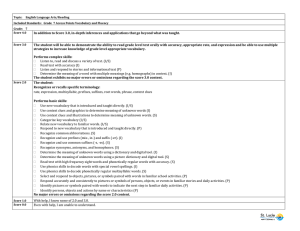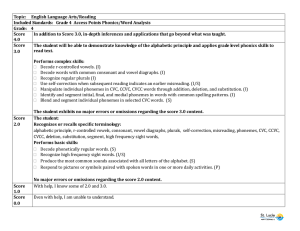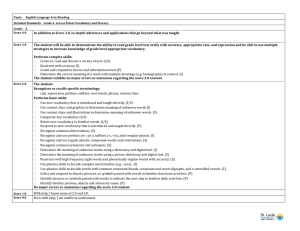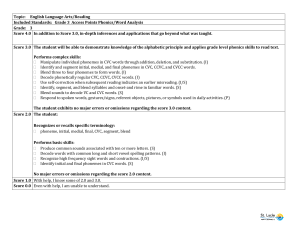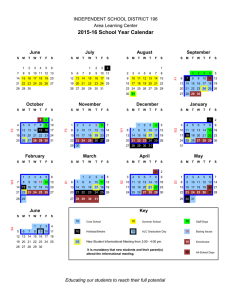Topic: English Language Arts/Reading
advertisement
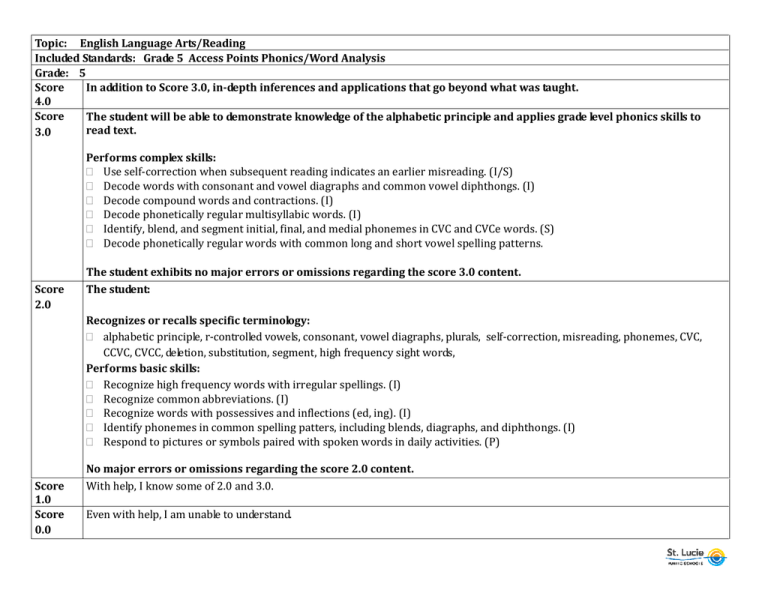
Topic: English Language Arts/Reading Included Standards: Grade 5 Access Points Phonics/Word Analysis Grade: 5 Score In addition to Score 3.0, in-depth inferences and applications that go beyond what was taught. 4.0 Score The student will be able to demonstrate knowledge of the alphabetic principle and applies grade level phonics skills to read text. 3.0 Performs complex skills: Use self-correction when subsequent reading indicates an earlier misreading. (I/S) Decode words with consonant and vowel diagraphs and common vowel diphthongs. (I) Decode compound words and contractions. (I) Decode phonetically regular multisyllabic words. (I) Identify, blend, and segment initial, final, and medial phonemes in CVC and CVCe words. (S) Decode phonetically regular words with common long and short vowel spelling patterns. Score 2.0 The student exhibits no major errors or omissions regarding the score 3.0 content. The student: Recognizes or recalls specific terminology: alphabetic principle, r-controlled vowels, consonant, vowel diagraphs, plurals, self-correction, misreading, phonemes, CVC, CCVC, CVCC, deletion, substitution, segment, high frequency sight words, Performs basic skills: Recognize high frequency words with irregular spellings. (I) Recognize common abbreviations. (I) Recognize words with possessives and inflections (ed, ing). (I) Identify phonemes in common spelling patters, including blends, diagraphs, and diphthongs. (I) Respond to pictures or symbols paired with spoken words in daily activities. (P) Score 1.0 Score 0.0 No major errors or omissions regarding the score 2.0 content. With help, I know some of 2.0 and 3.0. Even with help, I am unable to understand. Topic: English Language Arts/Reading Included Standards: Grade 5 Access Points Vocabulary and Fluency Grade: 5 Score 4.0 In addition to Score 3.0, in-depth inferences and applications that go beyond what was taught. Score 3.0 Score 2.0 Score 1.0 Score 0.0 The student will be able to demonstrate the ability to read grade level text orally with accuracy, appropriate rate, and expression and be able to use multiple strategies to increase knowledge of grade level appropriate vocabulary. Performs complex skills: Listen to, read and discuss/talk about stories and informational text. (I/S) Listen and respond to stories and informational text (P) Identify the correct meaning of a word with multiple meanings in context. (I) Use new vocabulary that is introduced and taught directly. (I/S) Use context clues and graphics to determine meaning of unknown words (I) Use context clues and illustrations to determine meaning of unknown words. (S) The student exhibits no major errors or omissions regarding the score 3.0 content. The student: Recognizes or recalls specific terminology: rate, expression, prefixes, suffixes, root words, phrase, context clues Performs basic skills: Use information from print or visual reference materials to determine the meaning of unknown words. (S) Categorize key vocabulary (I/S) Relate new vocabulary to familiar words. (I/S) Respond to new vocabulary that is introduced and taught directly. (P) Recognize common abbreviations. (S) Recognize and use prefixes (re-, un-), suffixes (-s, -es), and irregular plurals. (I) Identify the meaning of words using knowledge of tense (ed, ing), plural endings, and regular contractions. (I) Identify common synonyms, antonyms, and homonyms. (I) Identify common synonyms, antonyms, and compound words using pictures. (S) Determine the meaning of unknown words using a picture dictionary and digital tool. (S) Read text with high frequency sight words and phonetically regular words with accuracy. (S) Read simple text with high frequency sight words and phonetically regular words with accuracy. (S) Respond accurately and consistently to pictures or symbols of persons, objects, or events in familiar stories and daily activities. (P) Select objects, pictures, or symbols paired with words that relate to familiar stories or activities. (P) Identify persons, objects and actions by name in daily activities. (P) No major errors or omissions regarding the score 2.0 content. With help, I know some of 2.0 and 3.0. Even with help, I am unable to understand. Topic: English Language Arts/Reading Included Standards: Grade 5 Access Points Comprehension Grade: 5 Score 4.0 In addition to Score 3.0, in-depth inferences and applications that go beyond what was taught. Score 3.0 Score 2.0 The student will be able to use a variety of strategies to comprehend grade level text. Performs complex skills: Use strategies to repair comprehension, including but not limited to rereading, checking context clues, predicting, using simple graphic organizers, connecting life experiences, and checking own understanding when reminded. (I/S) Use a resource when necessary to clarify meaning of pictures, symbols, or words in classroom activities. (P) Identify the author’s purpose (e.g., to tell a story, give information, entertain) using key words, phrases, and graphics in text. (I) Identify similarities and differences in elements (e.g., characters, elements, objects, and actions) in text. Identify cause and effect relationships in stories and informational text. (I) Identify explicit text structures (e.g., similarities and differences, sequence of events, explicit cause/effect) in stories and informational text. (I) Identify the essential message or topic in text. (I) Identify actions that lead to predictable effects in read-aloud stories and informational text. (S) Identify differences in characters, actions, and objects in text. (S) Identify explicit ideas and information in text, including but not limited to main idea or topic, supporting details (e.g., who, what, where, when, how), and sequence of events. (I) The student exhibits no major errors or omissions regarding the score 3.0 content. The student: Recognizes or recalls specific terminology: text feature, prediction, author’s purpose, main idea, supporting detail, cause/effect, similarities, differences Performs basic skills: Determine main idea and supporting details, including who, what, where, and when in read-aloud stories and informational text. (S) Identify illustrations of characters or objects in read-aloud stories or informational text. (P) Use pictures or symbols paired with words to respond to predictable cause/effect events in daily activities. (P) Identify statements of main ideas or topic in read-aloud text. (S) Preview text features (e.g., illustrations, title) and use prior knowledge to make predictions of content of stories and informational text. (S) Preview text features (e.g., illustrations, title, headings, and captions) and use prior knowledge to make predictions of content and purpose of text. (I) Sort familiar books into categories reflecting personal uses (e.g., make me laugh, tell a story, show me how to do something). (S) Respond accurately and consistently to pictures or symbols paired with words in familiar read-aloud stories and informational text. (P) Respond to feelings expressed in read-aloud stories and informational text. (P) No major errors or omissions regarding the score 2.0 content. Score 1.0 Score 0.0 With help, I know some of 2.0 and 3.0. Even with help, I am unable to understand.
